The document discusses different perspectives on software quality. It begins by providing context on the ongoing issues with software quality according to articles from 2005 and 2006. It then discusses various views on defining quality, including philosophical, pragmatic, and perspectives focusing on users, manufacturers, products, and value. The document emphasizes that high quality software results from an effective process that creates useful, valuable products for both developers and users.
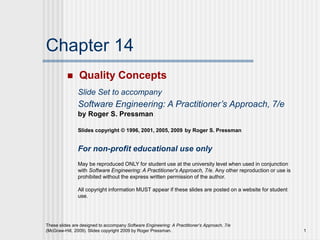
![These slides are designed to accompany Software Engineering: A Practitioner’s Approach, 7/e
(McGraw-Hill, 2009). Slides copyright 2009 by Roger Pressman. 2
Software Quality
In 2005, ComputerWorld [Hil05] lamented that
“bad software plagues nearly every organization that uses
computers, causing lost work hours during computer downtime,
lost or corrupted data, missed sales opportunities, high IT support
and maintenance costs, and low customer satisfaction.
A year later, InfoWorld [Fos06] wrote about the
“the sorry state of software quality” reporting that the quality
problem had not gotten any better.
Today, software quality remains an issue, but who is to blame?
Customers blame developers, arguing that sloppy practices lead
to low-quality software.
Developers blame customers (and other stakeholders), arguing
that irrational delivery dates and a continuing stream of changes
force them to deliver software before it has been fully validated.](https://image.slidesharecdn.com/chapter14sp1718-221123111859-e7c70e1f/85/Chapter_14-sp1718-ppt-2-320.jpg)

![These slides are designed to accompany Software Engineering: A Practitioner’s Approach, 7/e
(McGraw-Hill, 2009). Slides copyright 2009 by Roger Pressman. 4
Quality—A Philosophical View
Robert Persig [Per74] commented on the thing we call quality:
Quality . . . you know what it is, yet you don't know what it is. But that's self-
contradictory. But some things are better than others, that is, they have more
quality. But when you try to say what the quality is, apart from the things that have
it, it all goes poof! There's nothing to talk about. But if you can't say what Quality
is, how do you know what it is, or how do you know that it even exists? If no one
knows what it is, then for all practical purposes it doesn't exist at all. But for all
practical purposes it really does exist. What else are the grades based on? Why else
would people pay fortunes for some things and throw others in the trash pile?
Obviously some things are better than others . . . but what's the betterness? . . . So
round and round you go, spinning mental wheels and nowhere finding anyplace to
get traction. What the hell is Quality? What is it?](https://image.slidesharecdn.com/chapter14sp1718-221123111859-e7c70e1f/85/Chapter_14-sp1718-ppt-4-320.jpg)

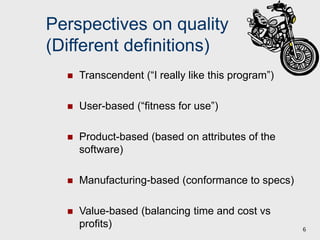

![These slides are designed to accompany Software Engineering: A Practitioner’s Approach, 7/e
(McGraw-Hill, 2009). Slides copyright 2009 by Roger Pressman. 8
Software Quality
Software quality can be defined as:
An effective software process applied in a manner that creates a
useful product that provides measurable value for those who
produce it and those who use it.
This definition has been adapted from [Bes04] and replaces a
more manufacturing-oriented view presented in earlier editions
of this book.](https://image.slidesharecdn.com/chapter14sp1718-221123111859-e7c70e1f/85/Chapter_14-sp1718-ppt-8-320.jpg)

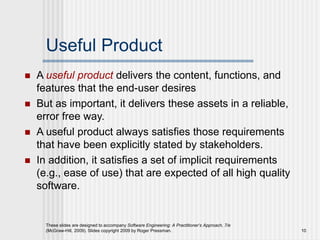

![12
Quality Dimensions
David Garvin [Gar87]:
1. Performance Quality. Does the software deliver all content, functions, and features
that are specified as part of the requirements model in a way that provides value to
the end-user?
2. Feature quality. Does the software provide features that surprise and delight first-
time end-users?
3. Reliability. Does the software deliver all features and capability without failure? Is it
available when it is needed? Does it deliver functionality that is error free?
4. Conformance. Does the software conform to local and external software standards
that are relevant to the application? Does it conform to de facto design and coding
conventions? For example, does the user interface conform to accepted design rules
for menu selection or data input?
5. Durability. Can the software be maintained (changed) or corrected (debugged)
without the inadvertent generation of unintended side effects? Will changes cause
the error rate or reliability to degrade with time?
6. Serviceability. Can the software be maintained (changed) or corrected (debugged)
in an acceptably short time period. Can support staff acquire all information they
need to make changes or correct defects?
7. Aesthetics. Most of us would agree that an aesthetic entity has a certain elegance,
a unique flow, and an obvious “presence” that are hard to quantify but evident
nonetheless.
8. Perception. In some situations, you have a set of prejudices that will influence your
perception of quality.](https://image.slidesharecdn.com/chapter14sp1718-221123111859-e7c70e1f/85/Chapter_14-sp1718-ppt-12-320.jpg)
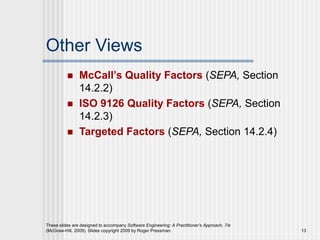
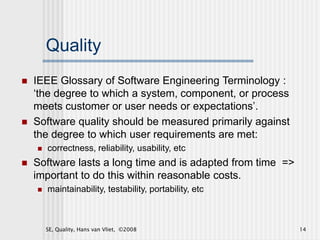
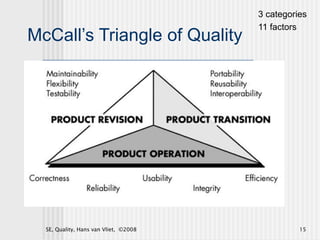
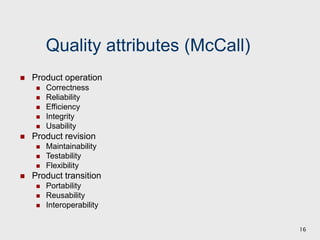




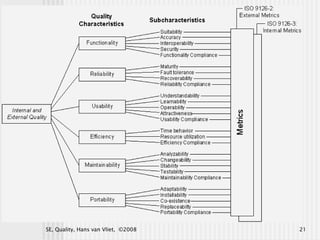
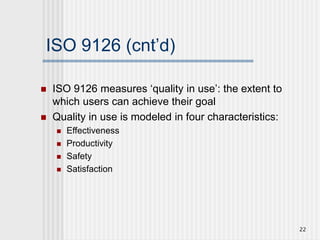
![These slides are designed to accompany Software Engineering: A Practitioner’s Approach, 7/e
(McGraw-Hill, 2009). Slides copyright 2009 by Roger Pressman. 23
The Software Quality Dilemma
If you produce a software system that has terrible quality, you lose
because no one will want to buy it.
If on the other hand you spend infinite time, extremely large effort,
and huge sums of money to build the absolutely perfect piece of
software, then it's going to take so long to complete and it will be so
expensive to produce that you'll be out of business anyway.
Either you missed the market window, or you simply exhausted all
your resources.
So people in industry try to get to that magical middle ground where
the product is good enough not to be rejected right away, such as
during evaluation, but also not the object of so much perfectionism
and so much work that it would take too long or cost too much to
complete. [Ven03]](https://image.slidesharecdn.com/chapter14sp1718-221123111859-e7c70e1f/85/Chapter_14-sp1718-ppt-23-320.jpg)

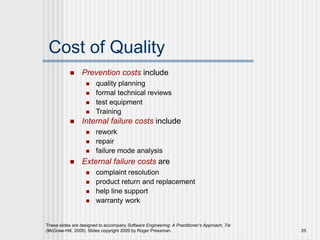


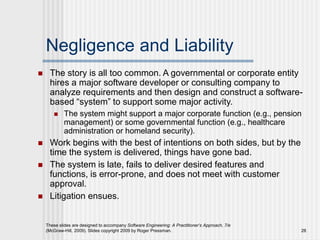
![These slides are designed to accompany Software Engineering: A Practitioner’s Approach, 7/e
(McGraw-Hill, 2009). Slides copyright 2009 by Roger Pressman. 29
Quality and Security
Gary McGraw comments [Wil05]:
“Software security relates entirely and completely to quality. You
must think about security, reliability, availability, dependability—at
the beginning, in the design, architecture, test, and coding phases,
all through the software life cycle [process]. Even people aware of
the software security problem have focused on late life-cycle stuff.
The earlier you find the software problem, the better. And there are
two kinds of software problems. One is bugs, which are
implementation problems. The other is
software flaws—architectural problems in
the design. People pay too much attention to bugs and not
enough on flaws.”](https://image.slidesharecdn.com/chapter14sp1718-221123111859-e7c70e1f/85/Chapter_14-sp1718-ppt-29-320.jpg)
